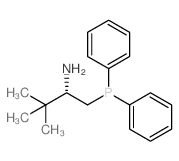(S)-1-(DIPHENYLPHOSPHINO)-3,3-DIMETHYLBUTAN-2-AMINE
Modify Date: 2024-01-10 17:24:38

(S)-1-(DIPHENYLPHOSPHINO)-3,3-DIMETHYLBUTAN-2-AMINE structure
|
Common Name | (S)-1-(DIPHENYLPHOSPHINO)-3,3-DIMETHYLBUTAN-2-AMINE | ||
|---|---|---|---|---|
| CAS Number | 286454-86-2 | Molecular Weight | 285.36400 | |
| Density | N/A | Boiling Point | N/A | |
| Molecular Formula | C18H24NP | Melting Point | N/A | |
| MSDS | Chinese USA | Flash Point | >230 °F | |
| Symbol |

GHS05 |
Signal Word | Danger | |
| Name | (2S)-1-diphenylphosphanyl-3,3-dimethylbutan-2-amine |
|---|---|
| Synonym | More Synonyms |
| Molecular Formula | C18H24NP |
|---|---|
| Molecular Weight | 285.36400 |
| Exact Mass | 285.16500 |
| PSA | 39.61000 |
| LogP | 4.19300 |
|
Section 1: Product Identification Chemical Name:(S)-1-(Diphenylphosphino)-2-amino-3,3-dimethylbutane, min. 97% (10wt% in hexanes) CAS Registry Number:286454-86-2 Formula:C18H24NP EINECS Number:none Chemical Family:organophosphine ligand Synonym:none
Section 2: Composition and Information on Ingredients IngredientCAS NumberPercentACGIH (TWA)OSHA (PEL) Title compound286454-86-210%no datano data Hexanes73513-42-590%50ppm1800mg/m3 Section 3: Hazards Identification Extremely flammable liquid. Vapors irritating to skin, eyes and respiratory tract. Inhalation of vapors may Emergency Overview: depress central nervous system causing dizziness, headache and nausea. Primary Routes of Exposure:Ingestion, inhalation Eye Contact:Contact will cause irritation, redness and a burning sensation. Skin Contact:Contact with skin can result in local irritation. May be absorbed through skin. Inhalation of vapors may depress the central nervous system causing dizziness, difficulty in walking and Inhalation: irritation to the lungs. Ingestion may cause gastrointestinal irritation, nausea, vomiting and headache. May cause lung damage if Ingestion: swallowed. Irritating to skin, eyes and respiratory tract. Harmful by inhalation. Ingestion may cause gastrointestinal Acute Health Affects: irritation, nausea, vomiting and headache. Possible risk of harm to the unborn child. Chronic Health Affects:No information on long-term chronic effects. Possible risk of impaired fertility. NTP:No IARC:No OSHA:No SECTION 4: First Aid Measures Immediately flush the eyes with copious amounts of water for at least 10-15 minutes. A victim may need Eye Exposure: assistance in keeping their eye lids open. Get immediate medical attention. Wash the affected area with water. Remove contaminated clothes if necessary. Seek medical assistance if Skin Exposure: irritation persists. Remove the victim to fresh air. Closely monitor the victim for signs of respiratory problems, such as difficulty Inhalation: in breathing, coughing, wheezing, or pain. In such cases seek immediate medical assistance. Seek medical attention immediately. Keep the victim calm. Give the victim water (only if conscious). Induce Ingestion: vomiting only if directed by medical personnel. SECTION 5: Fire Fighting Measures Flash Point:-14.8°F (hexane) Autoignition Temperature:no data Explosion Limits:LEL(1.7%) UEL(7.7%) hexane Extinguishing Medium:carbon dioxide, dry powder or foam If this product is involved in a fire, fire fighters should be equipped with a NIOSH approved positive pressure Special Fire Fighting Procedures: self-contained breathing apparatus and full protective clothing. Hazardous Combustion andIf involved in a fire this material may emit toxic and irritating fumes. Decomposion Products: Unusual Fire or Explosion Hazards: Highly flammable. Vapors can form explosive mixtures in air. SECTION 6: Accidental Release Measures If spilled, all personnel must be immediately evacuated and the area sealed off. The material may self-ignite Spill and Leak Procedures:releasing toxic and corrosive fumes of phosphorus pentoxide. Ventilation should be available. If entry into the area is required, personnel should be fitted with a self-contained breathing apparatus. SECTION 7: Handling and Storage Store in a tightly sealed container under an inert atmosphere of nitrogen or argon. Keep away from heat. Handling and Storage: Material should be transferred under an inert atmosphere of nitrogen or argon in an efficient fume hood. SECTION 8: Exposure Controls and Personal Protection Eye Protection:Always wear approved safety glasses when handling a chemical substance in the laboratory. Skin Protection:Wear protective clothing and gloves. Ventilation:Handle the material in an efficient fume hood. If ventilation is not available a respirator should be worn. The use of respirators requires a Respirator Respirator: Protection Program to be in compliance with 29 CFR 1910.134. Ventilation:Handle the material in an efficient fume hood. Additional Protection:No additional protection required. SECTION 9: Physical and Chemical Properties Color and Form:colorless liquid Molecular Weight:285.36 Melting Point:no data Boiling Point:68°C (hexane) Vapor Pressure:no data Specific Gravity:no data Odor:faint noxious odor Solubility in Water:insoluble SECTION 10: Stability and Reactivity Stability:air sensitive Hazardous Polymerization:no hazardous polymerization Conditions to Avoid:contact with oxidizing agents, ignition sources and prolonged exposure to air Incompatibility:strong oxidizing agents and halogens Decomposition Products:carbon monoxide, carbon dioxide, phosphorous oxides and organic fumes SECTION 11: Toxicological Information Title compound: No information available in the RTECS files. Hexane: Inhalation(humane); TCLo: 190ppm/8W. Inhalation(rat); LC50: 48000ppm/4H. Intraperitoneal(rat); LDLo: 9100mg/kg. Inhalation(mouse); LCLo: 120g/m3. Intravenous(mouse); LDLo: 831mg/kg. Intravenous(rabbit); LDLo: 132mg/kg. Oral(rat); TDLo: RTECS Data: 20000mg/kg. Oral(rat); LD50: 15840mg/kg. Inhalation(rat); TCLo: 1000ppm/4H/59W (intermittent)-Tumorigenic-carcinogenic by RTECS criteria. Inhalation(rat); TCLo: 10000ppm/7H; female-1-18 days after conception-behavorial effects on newborn. Carcinogenic Effects:Hexane: Insufficient data Mutagenic Effects:Hexane: Possible mutagen Tetratogenic Effects:Hexane: Possible reproductive effector SECTION 12: Ecological Information Hexane is very toxic to aquatic organisms. May cause long-term adverse effects in the aquatic environment. Ecological Information: Avoid release to the environment. SECTION 13: Disposal Considerations Disposal:Dispose of according to local, state and federal regulations. SECTION 14: Transportation Shipping Name (CFR):Flammable liquids, N.O.S. Hazard Class (CFR):3 Additional Hazard Class (CFR):NA Packaging Group (CFR):I UN ID Number (CFR):UN# 1993 Shipping Name (IATA):Flammable liquid, N.O.S. Hazard Class (IATA):3 Additional Hazard Class (IATA):NA Packaging Group (IATA):I UN ID Number (IATA):UN# 1993 SECTION 15: Regulatory Information TSCA:Not listed in the TSCA inventory SARA (Title 313):Not reportable under SARA 313. Second Ingredient:Hexane: Listed in the TSCA inventory. Reportable under SARA 313. SECTION 16 - ADDITIONAL INFORMATION N/A |
| Symbol |

GHS05 |
|---|---|
| Signal Word | Danger |
| Hazard Statements | H314 |
| Precautionary Statements | P280-P305 + P351 + P338-P310 |
| Hazard Codes | C |
| RIDADR | UN 2735PSN1 8 / PGIII |
| Flash Point(F) | >230 °F |
| Flash Point(C) | >110 °C |
| (S)-1-(DIPHENYLPHOSPHINO)-3,3-DIMETHYL-2-BUTYLAMINE |
| (S)-1-(diphenylphosphino)-3,3-dimethyl-2-butanamine |
| (S)-1-(DIPHENYLPHOSPHINO)-2-AMINO-3,3-DIMETHYLBUTANE |
| (S)-2-AMINO-1-DIPHENYLPHOSPHINO-3,3-DIMETHYLBUTANE |
| (S)-1-(Diphenylphosphino)-3,3-dimethylbutan-2-amine |